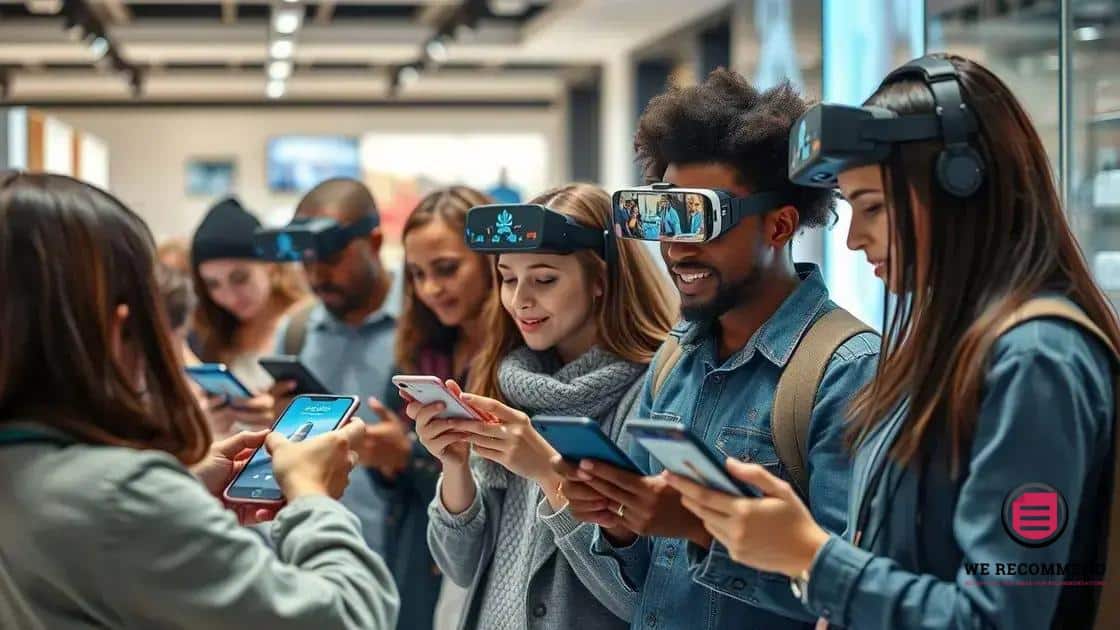AR in digital advertising: Is your strategy up to date?

Anúncios
Augmented reality (AR) in digital advertising enhances consumer engagement by providing immersive, interactive experiences while overcoming challenges such as technical limitations and high development costs.
AR in digital advertising opens up exciting possibilities for brands looking to enhance customer interactions. Have you ever wondered how this technology could elevate your marketing game? Let’s dig into its innovative applications.
Anúncios
Understanding augmented reality in advertising
Understanding augmented reality (AR) in advertising begins with recognizing its immersive nature. AR blends digital content with the real world, allowing consumers to interact with products in new ways.
Anúncios
This technology uses smartphones or special glasses to enhance the user experience. By integrating virtual elements into physical surroundings, brands can create engaging and memorable campaigns.
Key Features of AR in Advertising
AR can significantly increase customer engagement through its ability to:
- Provide interactive product demonstrations.
- Allow customers to virtually try on products.
- Enhance storytelling by bringing brand narratives to life.
For more information, you can visit the Forbes Tech Council.
Benefits of AR for brand engagement
Augmented reality (AR) offers unique benefits that significantly enhance brand engagement. By creating immersive experiences, AR captures the attention of consumers in innovative ways.
With AR, brands can forge deeper connections with their audience, making interactions more memorable. Customers are more likely to participate with content that feels interactive and engaging.
Key Advantages of AR in Brand Engagement
The compelling features of AR include:
- Enhanced product visualization, allowing customers to see how products fit into their lives.
- Increased customer interaction through gamified experiences or immersive storytelling.
- Stronger emotional connections that lead to brand loyalty and repeat purchases.
For further insight into the impact of AR, visit Marketing Dive.
Best practices for implementing AR campaigns
Implementing AR campaigns effectively requires careful planning and execution. Brands should focus on creating meaningful experiences that engage users and inspire action.
AR campaigns can be powerful tools for marketing, but they must resonate with the target audience. Ensuring that the content is accessible and user-friendly is crucial.
Best Practices for AR Campaigns
To maximize the effectiveness of AR in your advertising strategy, consider the following:
- Start with a clear goal: Define what you want to achieve with your AR campaign.
- Ensure compatibility: Make sure your AR experience works well across devices and platforms.
- Focus on storytelling: Use AR to tell a captivating story that aligns with your brand.
For more insight, you can check out Walmart’s Guide for launching AR experiences.
AR vs. traditional advertising: A comparison

Augmented reality (AR) offers a fresh perspective compared to traditional advertising methods. While traditional advertising relies on static images and text, AR creates immersive experiences that engage consumers in new ways.
With AR, brands can seamlessly integrate digital content into the real world, making advertisements more interactive. This engagement leads to higher retention rates and often a better response from the audience.
Comparative Features
Here are key differences between AR and traditional advertising:
- Engagement: AR offers interactive content, while traditional ads are often one-dimensional.
- Customer Experience: Users can visualize products in real environments through AR; traditional advertising does not provide this level of interactivity.
- Feedback Mechanism: AR can track engagement in real time, helping brands adjust campaigns quickly, unlike traditional methods that are less dynamic.
For an extensive comparison, check out Adweek for insights on AR’s impact on advertising strategies.
Innovative AR examples from top brands
Many top brands are leveraging augmented reality (AR) to create innovative marketing campaigns that engage customers. These brands use AR to enhance customer experiences by providing immersive interactions.
By adopting AR, companies can showcase their products in unique and interactive ways. Here are some notable examples:
Leading Brands Utilizing AR
- IKEA: The IKEA Place app allows users to visualize furniture in their home before purchasing. With AR, customers can see how items fit their space.
- Sephora: The Sephora Virtual Artist app enables customers to try on makeup virtually. This tool helps shoppers experiment with different looks from the comfort of their homes.
- Pepsi: In a creative campaign, Pepsi created AR-enabled bus shelters that surprised commuters with virtual experiences, like animated characters and fun scenarios.
For more examples and insights on AR in branding, visit Forbes.
Measuring the success of AR initiatives
Measuring the success of augmented reality (AR) initiatives is crucial to understand their impact on marketing efforts. Brands need to track various metrics to evaluate the effectiveness of their AR campaigns.
By analyzing these metrics, companies can adjust strategies to enhance user engagement and improve return on investment (ROI).
Key Metrics for Success
Here are important metrics to consider when measuring AR initiatives:
- Engagement Rate: Track how many users interact with the AR experience and for how long.
- Conversion Rate: Measure how many users made purchases or took desired actions after engaging with the AR content.
- User Feedback: Collect qualitative data from users to understand their experiences and satisfaction with the AR campaign.
For a deeper dive into measuring AR success, check out Digital Marketing Institute.
Challenges and limitations of AR in advertising
Augmented reality (AR) offers exciting possibilities in advertising, but it also presents several challenges and limitations that brands must navigate. Understanding these hurdles is crucial for successful implementation.
As the technology evolves, companies must address specific obstacles to maximize the benefits of AR in their marketing strategies.
Common Challenges in AR Advertising
Here are some notable challenges that can affect AR initiatives:
- Technical Limitations: Not all devices support AR well, which can limit audience reach and engagement.
- Cost of Development: Creating high-quality AR experiences can be expensive and resource-intensive.
- User Acceptance: Some users may be hesitant to adopt AR technology, requiring brands to educate and encourage participation.
To learn more about navigating these challenges, visit Built In for detailed insights.
Future trends in AR and digital marketing

The future of augmented reality (AR) in digital marketing looks promising. As technology continues to advance, AR is expected to play a more significant role in how brands engage with consumers.
With increasing smartphone adoption and improvements in AR technology, marketers can create even more immersive experiences.
Emerging Trends in AR Marketing
Here are some future trends to watch for in AR and digital marketing:
- Increased Personalization: Brands will use AR to offer personalized experiences tailored to individual user preferences.
- Integration with E-commerce: AR will seamlessly integrate with online shopping, allowing customers to visualize products before purchase.
- Social Media Augmentation: Platforms like Instagram and Snapchat will enhance their AR features, giving brands new ways to connect with users.
To explore more about these trends, visit Forbes for insightful analyses.
The Future of Augmented Reality in Advertising
Embracing augmented reality (AR) can transform how brands connect with their audience. From enhancing customer engagement to providing innovative shopping experiences, AR is becoming a vital tool in digital marketing.
As technology advances, the opportunities for AR in advertising will only grow. Businesses that adapt and invest in AR initiatives will find themselves ahead of the curve. By staying informed about trends and best practices, brands can create immersive experiences that resonate with consumers.
Thus, leveraging AR effectively can not only drive sales but also build lasting customer relationships in an ever-evolving digital landscape.
FAQ – Frequently Asked Questions About Augmented Reality in Advertising
What is augmented reality in advertising?
Augmented reality (AR) in advertising is a technology that overlays digital information or experiences onto the real world, enhancing user engagement with interactive content.
How can brands measure the success of their AR campaigns?
Brands can measure success by tracking metrics such as engagement rates, conversion rates, and user feedback to determine the effectiveness of their AR initiatives.
What are some common challenges brands face when using AR in marketing?
Common challenges include technical limitations, high development costs, and user acceptance, which can impact the reach and effectiveness of AR campaigns.
What are the future trends for AR in digital marketing?
Future trends include increased personalization, integration with e-commerce, and enhanced social media interaction, leading to more immersive customer experiences.






